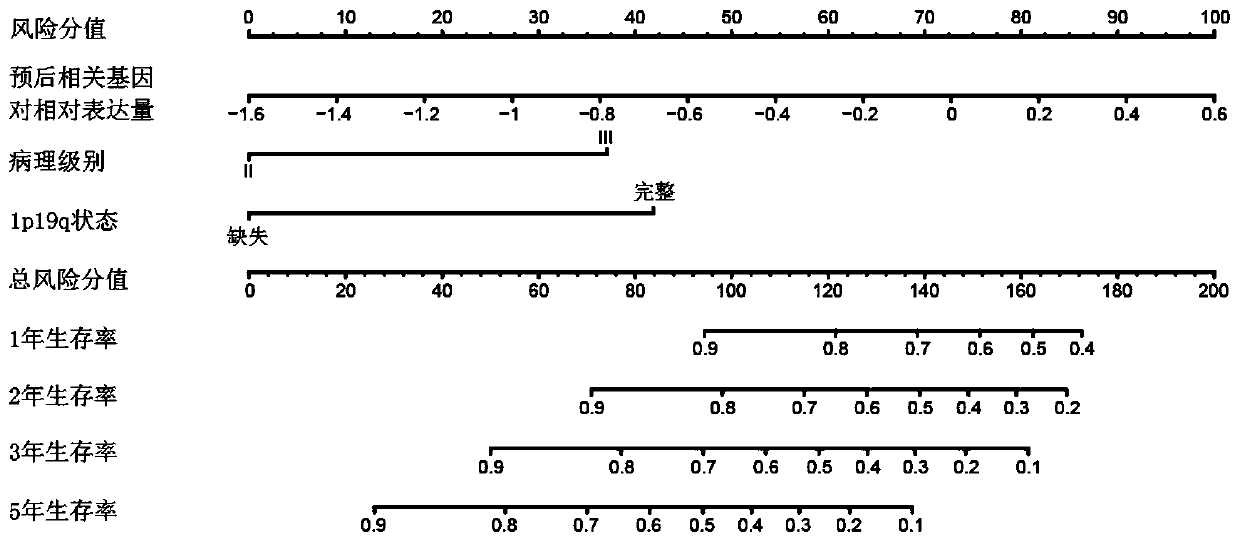Tumor patient lifetime prediction system
A tumor patient and prediction system technology, applied in health index calculation, medical simulation, medical informatics, etc., can solve the problems of molecular marker overfitting, inability to use, data set heterogeneity and cross-platform detection technology deviation. , to achieve the effect of easy access, saving time and energy
- Summary
- Abstract
- Description
- Claims
- Application Information
AI Technical Summary
Problems solved by technology
Method used
Image
Examples
Embodiment 1
[0096] This embodiment takes lower-grade glioma as an example to illustrate the establishment method of the system model for predicting the survival of tumor patients in the present disclosure
[0097] A set of transcriptome expression profile data from 172 patients with lower-grade glioma in China was collected as the discovery group, and 2214 immune genes related to lower-grade glioma were screened out from the discovery group data, and the immune genes of these immune genes were analyzed. A database containing 2,449,791 immune gene pairs was established by pairwise comparison of expression levels. Assuming that gene i and gene j are a gene pair in the database, in a patient, if the expression of gene i is greater than the expression of gene j, the gene pair will be recorded as 1, if the expression of gene i is less than is equal to the expression level of gene j, the gene pair is recorded as 0. If the expression results of a gene pair in more than 95% of the patients were ...
Embodiment 2
[0115] This embodiment is used to verify the prediction accuracy of the lower-grade glioma patient survival prediction system in Example 1
[0116] A set of transcriptome expression profile data of 171 lower-grade glioma patients from China was collected as an internal validation group; a set of transcriptome expression profile data of 415 lower-grade glioma patients from the United States was collected as an external validation set.
[0117] The survival period prediction system for patients with lower-grade glioma provided in Example 1 was used to predict the survival period, and the consistency between the prediction result and the actual survival time of the patient was compared.
[0118] The results show that the lower-grade glioma patient survival prediction system in Example 1 has a consistency of 0.79 between the survival prediction results of the patients in the internal validation group and the actual survival time of the patients; the lower-grade glioma patients in E...
Embodiment 3
[0120] Using PCR technology to verify the accuracy of the prediction results of the survival period of 36 patients with lower grade glioma patients provided by the lower grade glioma survival prediction system provided in Example 1
[0121] The above CRH-IFNB1, HOXA9-PRG3, IL10-IL9, IL9-PTH2, IL9-RETNLB, NKX2-5-PRLH, NKX3-2-UCN3, NR2C1-PTX3, PRLHR-REG1A and PRLHR-TRIM31 were detected by quantitative PCR technology The relative expression values of the constituent genes of the 10 immune gene pairs; the pathological grade and 1p19q status of the patients were obtained through the pathology department, and the nomogram model was used to calculate the survival probability of the patients as control data.
[0122] The survival period prediction system for patients with lower-grade glioma provided in Example 1 was used to predict the survival period, and the consistency of the prediction results with the control data was compared.
[0123] The results show that the survival predic...
PUM
 Login to View More
Login to View More Abstract
Description
Claims
Application Information
 Login to View More
Login to View More - R&D
- Intellectual Property
- Life Sciences
- Materials
- Tech Scout
- Unparalleled Data Quality
- Higher Quality Content
- 60% Fewer Hallucinations
Browse by: Latest US Patents, China's latest patents, Technical Efficacy Thesaurus, Application Domain, Technology Topic, Popular Technical Reports.
© 2025 PatSnap. All rights reserved.Legal|Privacy policy|Modern Slavery Act Transparency Statement|Sitemap|About US| Contact US: help@patsnap.com


